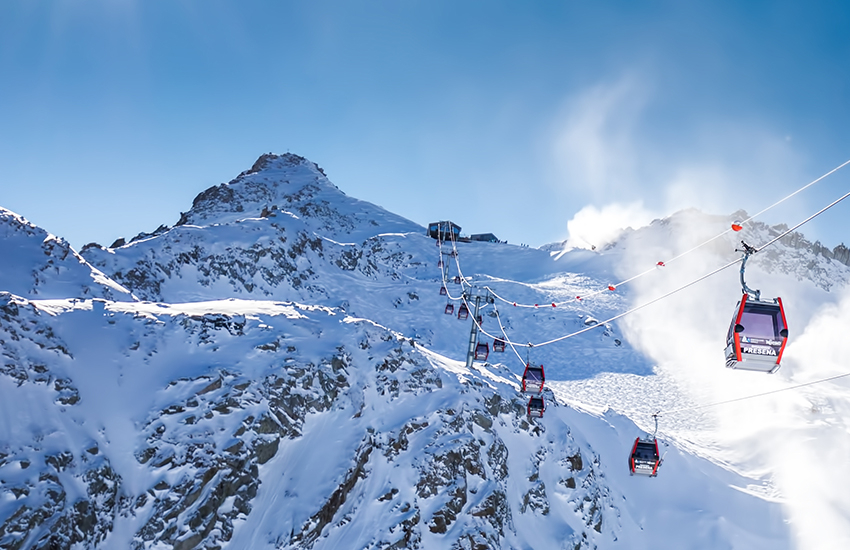
In an interview featured in The Telegraph, actress Mariel Hemingway disputes the idea that grandpa Ernest wrote his stories under the influence of alcohol.
“So many writers glorify my grandfather’s way of living as much as they glorify his work. And so they try and mirror that. I think it’s the misconception of addiction and living life on the edge, as if it’s cool,” she argues.
Ernest Hemingway did indeed live his life on the edge: on the edges of his skis, and on the edges of the glaciers of Europe. The kinetic nature of his stories shows traces of skiing-induced exhilaration and a mind that lived on the precipice of danger and adventure. He often said that writing broadens both the ass and the mind while noting that he liked to write standing up.
This makes us wonder how many stories he concocted not just from an upright position, but while soaring down the slopes of Europe. Many of these ski areas eventually evolved into upscale resorts. Things were different back then.
Hemingway in Austria
Singers and poets praise Paris in the springtime, but few enjoy the cold, damp Parisian winters. In the winter of 1924, Hemingway, his wife, Hadley, and their infant son, nicknamed Bumby, sublet their apartment in Paris fled the city for Schruns, in Austria’s Vorarlberg. From Thanksgiving until Easter, they stayed, for about $2 a day, at the Hotel Taube, skiing by day and playing poker by night.
The family stayed in adjoining rooms-Numbers 21 and 23. Since the latter room had a balcony facing the awe-inspiring Zambaspitze, Hemingway did all his writing in that room. During this sojourn, he completed the novel that made him famous, The Sun Also Rises.
In a letter to a friend, Hemingway writes:
“If you don’t come down, you are not only a low son-of-a-bitch but also ignorant. . . . Best looking country you ever saw and swell hikes.”
Ernest and Hadley were students at Herr Walther Lent’s ski school in Schruns. Those were the days before ski lifts. In his book, The Moveable Feast, he describes his experience
“Anything you ran down from, you had to climb up to first, and you could run down only as often as you could climb up… Finally there was the great glacier run, smooth and straight, forever straight if your legs could hold it, your ankles locked, you running so low, leaning into the speed, dropping forever and forever in the silent hiss of the crisp powder. It was better than any flying or anything else, and you built the ability to do it and to have it with the long climbs, carrying the heavy rucksacks. You could not buy it nor take a ticket to the top. It was the end we worked all winter for, and all the winter built to make it possible.”
Lent was a superb skier, but a terrible poker player. To satisfy his gambling debts to Hemingway, he had to guide the Papa from Partenen to the Madlenerhaus. They left in the early morning and followed the steep, dark trail to the glistening snowfields. At the end of the journey, they stayed in a mountain Lodge called Madlener Haus.
Austria Skiing Today
Were he alive today, Hemingway would discover a revitalized Schruns and Montafon Valley for his expert skiing. Eleven resorts now comprise the Montafon, some of which have a vertical drop of more than 5,000 feet. Located in the southwest tip of Austria, the resorts of the Montafon Valley sit at altitudes ranging from 1,968 feet to 4,757 feet and include the Silvretta, the Raetikon and the Verwall.
Schruns has three mountains, including Sennigrat, the Grabs and the Golm. For those who do not claim expert status, a gondola runs up the two sides of Schruns and delivers you to easy runs through wide-open fields.
Hemingway in Gstaad, Switzerland
In 1927, Hemingway, pending divorce from Hadley, arrived in Gstaad, Switzerland with his soon-to-be new wife, Pauline Pfeiffer. This new Mrs. Hemingway was a fashion journalist, with high society connections and a respectably-sized trust fund. Gstaad was different from Schruns. Mike Reynolds, author of Hemingway: The Homecoming writes:
“It was the year of the avalanches in the Arlberg and Vorarlberg, but not at Gstaad where the slopes were more gentle and the clientele more genteel. At Gstaad, Count Rupert and Princess Estelle could enjoy the curling matches or cheer the slalom races.”
Gone were Hemingway´s unruly beard and grungy dress style, and the simplicity of the Hotel Taube no longer suited the Papa. Now, he preferred what was then considered the grandeur of the Hotel Rossli. Ironically, Gstaad has evolved into one of the world´s most upscale ski resorts, and the Hotel Rossli is now considered a budget hotel.